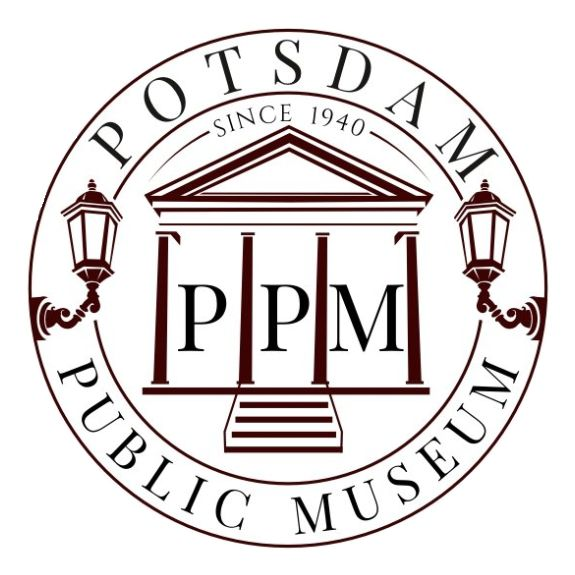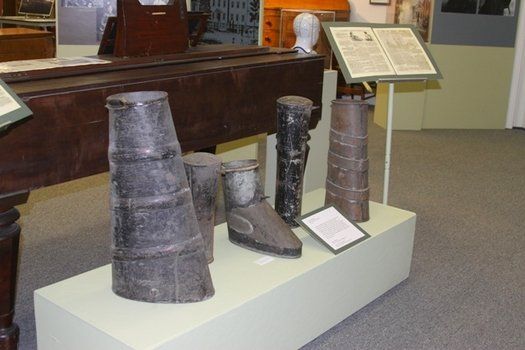Medical
MEDICAL MIRACLES, MYSTERIES AND MALADIES
A History of Local Contributions to the Medical Community
Potsdam – MEDICAL Miracles Mysteries and Maladies an exhibition on the history of the development of medical technology and its impact on the local area was held on exhibit from May 2, 2010 through October 15, 2010 at the Potsdam Public Museum, 2 Park Street, Civic Center, Potsdam, N.Y.
This exhibit highlighted local individuals that include: Dr. Hervey Thatcher, inventor of the milk bottle, and Linda Richards the nation’s first trained nurse who is credited for creating a system for charting and maintaining individual medical records for each patient. Several students from Clarkson University assisted the museum with research for this exhibit. They were enrolled in Dr. Laura Ettinger’s class; History 320: Medicine and Society in America.
The first physician to reside in Potsdam was Pierce Shepard. He arrived in 1807 or 1808, and joined the St. Lawrence Medical Society in 1808. He later became Potsdams first Post Master.

Robert McChesney, to the left, was a native of Troy, NY, and studied his profession in Cherry Valley and Springfield, NY. In 1810 he moved to Madrid and in the following year to Potsdam. He had a large and successful practice until his death in 1824.
Gideon F. Cole (photograph right taken in 1864), was born in 1811, trained at the Medical School at Fairfield, Herkimer Co. and moved to Potsdam from Herkimer County in 1837 at age 26 (approx.) He joined the St. Lawrence Medical Society in 1838. He was married to Thirza Gage sometime before they moved to Potsdam. They had just one child, Frisbee, who died of consumption at the age of 29. Dr. Cole died September 17, 1885.
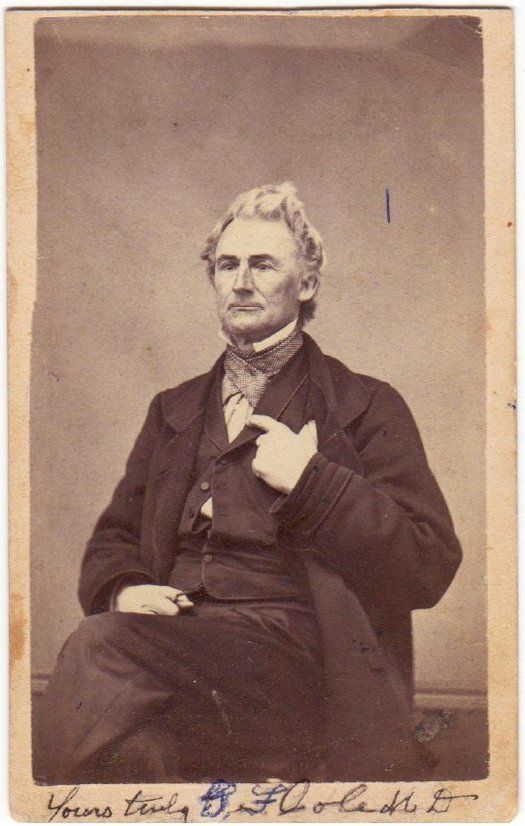
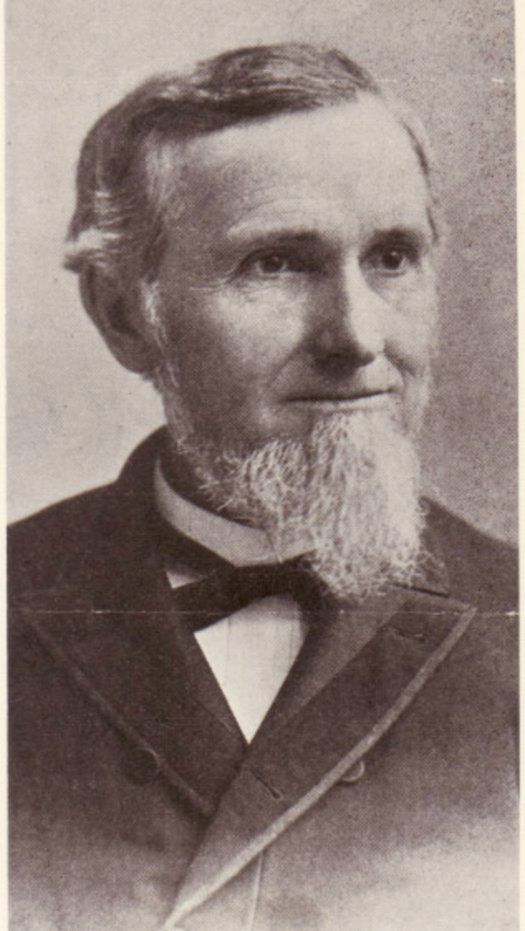
Dr. Hervey Thatcher (born December 28, 1835 in NH) was an inventor and a pharmacist. In 1865, he married Miss Olevia Adelaide Barnhart from Barnhart Island, near Massena. Never having children of their own, they invited nieces and nephews to stay with them. Dr. Thatcher died in Potsdam on May 24, 1925 at the age of 90 in an office in a plant on Maple St. where he made his home after a fire caught him without sufficient insurance and destroyed his business.
Dr. Thatcher attended academies in Newport, New London, and Washington, NH. He also went to academies in Potsdam and Ogdensburg. After this, he received a degree in Eclectic Medicine in Cincinnati, OH. He then operated a drugstore in Canton, and moved to Potsdam after this burned.
Here, in Potsdam, he opened another drugstore in what is now Wear on Earth. He ran this for about 30 years and after selling it, he focused on his inventing. One of his biggest contributions was the development of more sanitary ways to deliver milk. After seeing a little girl drop her rag doll in a milk can and then watch the milk man continue to distribute that milk, Dr. Thatcher decided something had to be done. First, he came up with the milk protector, and then he thought of the glass milk bottles.


After deciding the methods of cleaning these bottles was not efficient enough, he began to think of disposable paper containers. His milk bottle was not the first glass milk bottle; however, it is the best known. At first, his ideas were shunned and he had trouble convincing people that they were valid, but eventually he was able to get people on board. He worked with his brother-in-laws, Harvey and Samuel Barnhart.
Along with working to sanitize milk distribution, Dr. Thatcher filed for over 20 patents. These included: orange butter color, Sugar of Milk baking powder, different types of paper (for the disposable milk bottles), baking liquid, and two different checkers games: the King Bridge Checkers Game and the US Checkers Game.

Dr. Thatcher opened many businesses including Thatcher Manufacturing Co. He also helped set up the first milk pasteurization plant just outside of Ogdensburg. Later in his life he was a trustee of Clarkson and was involved in the Single Service Package Corporation of America in New York City.

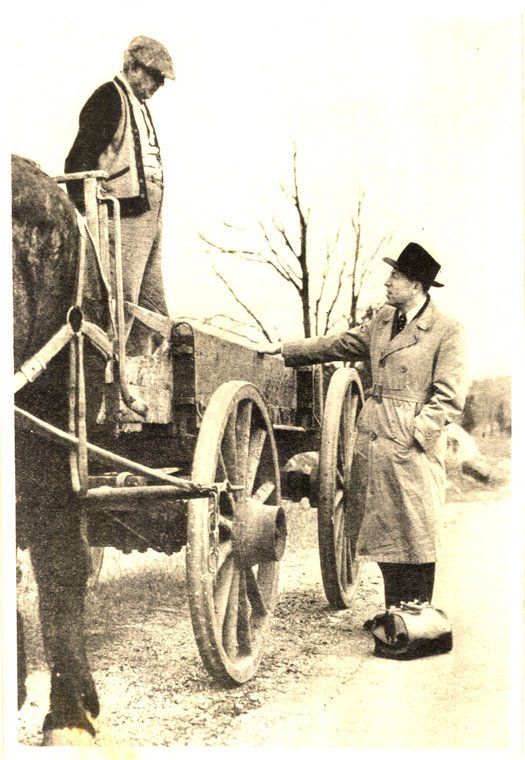
Shown left is Dr. Max Thaler of Parishville on Catherine Street standing next to Era Converse on his horse drawn manure wagon c.1950s. The image is from Ellen Beeler, Daughter of Dr. Max and Angela Thaler
Dr. Max Thaler (1909-1989) was born in Magierow, Poland, to poor Jewish parents. He completed his medical training at the University of Austria, where he met and married his wife of more than 50 years, Angela Brill Thaler. When World War II erupted, Max and Angela fled to Switzerland (a neutral country) to escape persecution. There Max served as physician in a refugee camp, and Angela gave birth to two children, Ellen and Joan.
In 1948 the young family moved to New York City to join Angela’s parents who had emigrated there before the war. During the next 2 years, Max completed his residency requirements and became licensed to practice medicine in New York State.
In 1950 Dr. Thaler opened a family practice in Parishville, New York. Over the next several decades he treated patients throughout the Parishville/Potsdam area, while Angela served as his nurse, assistant and office manager. It was a “cradle to grave” medical practice: and delivered babies, sewed up injuries, did house calls, and treated every ailment from a sore throat to cancer to dementia.
On display at the museums’ exhibit: MEDICAL MIRACLES MYSTERIES & MALADIES is Dr. Thaler’s medical bag shown in the photograph as well as his microscope from medical school in Vienna and other fascinating artifacts.

Doctor Edward Spurck Prescott (4 September 1908 to 8 January 1963) was born in Kirksville, Missouri, received his pre-medical training at Syracuse University and graduated from the Philadelphia College of Osteopathic Medicine. He interned at the Philadelphia Osteopathic Hospital, practiced with his father, Dr. Allen Prescott, in Syracuse for three years, then moved to Potsdam in 1936 where he was a practicing osteopathic surgeon until his death.
Dr. Prescott married Miss Doris Lucille Gates of Canton, Ohio, 12 June 1937. His brother, Dr. Allen S. Prescott was best man and Esther Ruth Gates, sister of the bride was maid of honor. Ushers were Mr. Herbert Gates, brother of the bride, and Dr. William Prescott, brother of the groom. They made their home first at 18 Garden Street, then in 1939, Dr. Prescott purchased the Pert house on Elm Street which became both home and office for the doctor. The couple had one daughter, Lucille, and two sons, Edward and Charles.

In 1948, Dr. Prescott and Kenneth Armstrong leased Damon field and operated the airport as a corporation under the name Potsdam Airways, Inc. Clayton Tillepaugh, a Clarkson student, was manager and licensed instructor. All three were licensed pilots.
Doctor Prescott was active in many areas of the Potsdam community. He was a member of the Potsdam United Methodist Church, a member of the department of medicine and family practice at the Canton-Potsdam Hospital, and was associated with the Inlet Outing Hunting Club. He was captain in the Civil Air Patrol, and inspector of the St. Lawrence Group. He was president and charter member of the Potsdam Lions Club and as a member, he was known as “an artist in the preparation of a beefsteak dinner”. He was a member of the Racquette River Lodge 212 F&AM, a life member of the Osteopathic Association and the New York Osteopathic Society. Dr. Prescott was also a member of the Knights Templar of Watertown, Potsdam Chamber of Commerce and served on the Potsdam Central School Board of Education for 25 years which include being president of the Board.
Dr. Marshall L. Stevenson has been named the recipient of the 1985 Board of Directors Service Award at Canton-Potsdam Hospital. Established in 1982, the annual award recognizes outstanding service to the community and the hospital. In making the award, board Chairman William Sloan commended Dr. Stevenson as a friend, a helper, and a caring person.
"Approximately 5,000 of the local citizens entered the world under his guidance," noted Mr. Sloan, "and he has tended to keep a watchful eye In the ensuing years." Dr. Stevenson, a native of Mooers, in Clinton County, graduated from Houghton College and Downstate Medical Center. He opened his practice of family medicine in Potsdam in 1939. He has served in numerous positions in the hospital and the community, continues his active medical practice, and is a member of the hospital's board of directors.
Past recipients of the service award have been the Edward John Noble and Potsdam Hospital Guilds, and area rescue squads.
COURIER & FREEMAN, POTSDAM, N.Y. TUESDAY, MARCH 6,1979
There will be an immunization clinic for pre-school children at the Potsdam Fire Station on March 13 from 9:30-11 a.m. Triple Vaccine, (diptheria, tetanus and whooping cough), Sabin oral polio vaccine, measles, rubella and mumps vaccine will be given. Mumps vaccine is now mandatory for school entrance. Bring records of child's previous immunications. Children must be two months of age. The clinic will be conducted by the Public Health Nurses under the supervision of Dr. Marshall Stevenson, health officer.
C0URIER & FREEMAN, POTSDAM, N.Y. TUESDAY, JUNE 5, 1979
June 15 — The Public Health Nurses will sponsor an immunization clinic to be held at St. Patrick's Church, Brasher Falls, on Friday from 10-11 a.m. At this •clinic, children may receive triple vaccine for protection against tetanus, diptheria, and hooping cough, oral pilio vaccine, measles-vaccine against both the red and German measles and Mumps Vaccine. Rubella (German) measles vaccine can be given to children up to ten years of age. The clinic will be under the supervision of Dr. Marshall Stevenson, health officer, and will be conducted by the Public Health Nurses

Medical Examination Table c. 1940s
This table features stirrups, pelvic tilt, foot extension, and hidden drop pan. It is made of wood, veneer, metal, and leather with a paper examination cloth dispenser. Purchased from the estate of Dr. Marshall Stevenson
Loaned by Tim O’Brien

When the nurse is shown wearing her cape it is not unusual to see one side flipped back to expose the red lining. This appears to be a common way of wearing the cape. The photograph to the left is of Mrs. C.H. Wheeler wearing the Red Cross uniform on display. Her maiden name was Miss Katherine Raymond Knowles (1860-1949).
John F. Butler served as both jeweler and optometrist in Potsdam from about 1901 until 1924. The sign hanging outside his place of business was not uncommon and was a good form of advertisement.


The people in this 1915 photograph (LEFT) are Mr. Perrin, Gladys Hughes and pharmacist , Mr. Remington.
Doctor Jacob Adest was an eye, ear, nose and throat physician, but specialized in eye care. You can see, in this 1990 photograph (RIGHT), how much the equipment has changed and improved over the years.

Advertisement: THE EQUALIZER - In 1959 Earl Pattison found an old tin boot at his home at 105 Market Street and donated it to the museum. It was a “curiosity” as the purpose of the boot was unknown. The mystery was solved by the museum staff by use of the internet in 2007 when the museum launched a display called Morbid Curiosity for Fright Night featuring the tin boot. In 2008, the Straub family donated a collection of tin boots, legs, and arms found in their garage at 17 Cedar Street, Potsdam, an advertisement for the Equalizer dated 1871 was rolled up inside the leg.

Uniform c.1914 - 1918
Smock, nurse’s Red Cross. White cotton with V-neck and long sleeves. Buttons in back. Veil goes with smock. World War I. Name in ink on inside back “Mrs. C.H. Wheeler”.
Gift of Mr. and Mrs. John R. Gardner
Uniform c. 1914 - 1918
Smock, nurse’s white muslin with square neck and two buttons in back. WWI. Goes with kerchief
Gift of Sara Snell Petersen
Cap c. 1914-1918
Cap, nurse’s, of heavy white cotton. Red Cross. World War I.
Gift of Sara Snell Petersen
Cape c. 1914 - 1918
Nurse’s navy wool flannel, red wool flannel lining.
Belonged to Mrs. Clara Asp, worn during WWI
Gift of Esther B. Wallace
Uniform c. 1914 - 1919
Uniform, woman’s, cotton, Red Cross WWI.
Cross over front, blue collar with red cross symbol. Short belt on front panels, buckles in back, calf length. Long sleeves with blue detachable cuffs. Two blue cotton veils with Red Cross emblem go with outfit.
Tag has “Sullivan” written on it.
Gift of anonymous donor


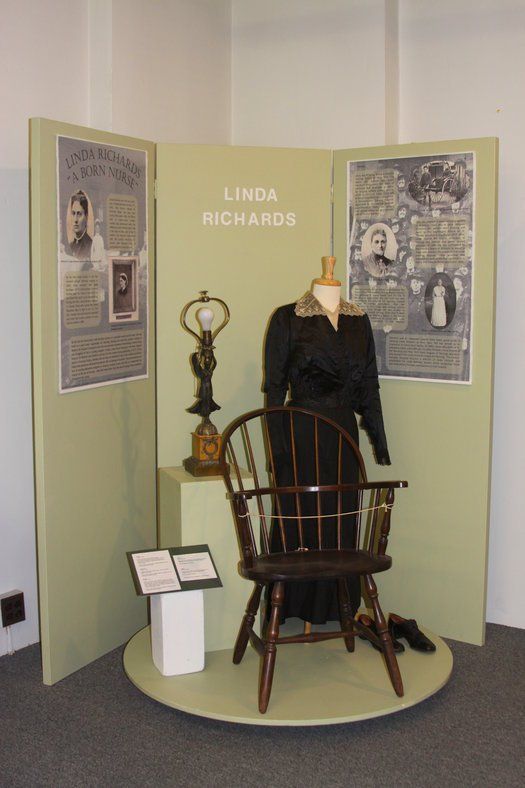
Uniform c. 1934
Nurse’s cape of navy wool with red wool lining. Standing collar with gold A.B.H.H. letters and two front closures. Worn by donor during her training at A. Barton Hepburn Hospital School of nursing in class of 1934.
Gift of Elsa Gibson
Medical c. 1915
Red Cross First Aid Kit containing 5 plastic vials with aluminum tops, roll of cotton gauze, safety pins, jar of salve, tin of adhesive plasters, and squares of gauze cotton.
Gift of Gretchen Sackett
Uniform c. 1945 - 1950
Uniform, woman’s, Red Cross, two piece of gray worsted.
Jacket: hip-length, long sleeves, lined, two pocket flaps on each side with red cross buttons, six buttons on front. Epaulets on shoulders with buttons. Two Red Cross pins on labels and round patch.
skirt: short, A-line, zipper closure.
Donor born in Potsdam, NY. Married Earl H. Donely in Presbyterian Church, Potsdam.
Gift of Eizabeth F. Donely
Uniform c.2009 -- Uniform, green cotton hospital “scrubs”. Top has short sleeves, V-neck and pocket. Bottom has straight legs and drawstring waist.
Loaned by Teri Ann Crump
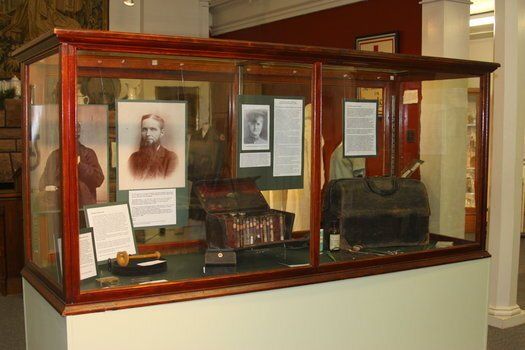
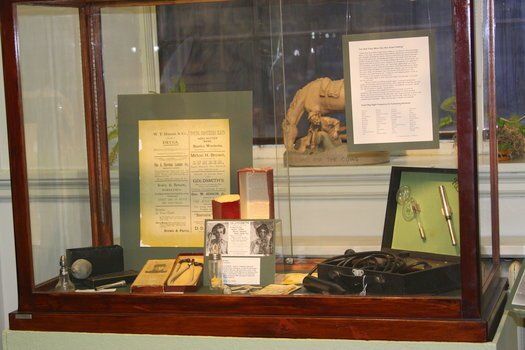

Chair c. 1850's - Mechanical saddle chair belonging to Judge Henry Knowles. “Halsteds Patent”. Painted black. From the Knowles Estate
Forceps c. 1860 - Dental, silver metal used to pull teeth.
Gift of William S. Remington
Turnkey c. 1860 used in extracting teeth. Metal with black handle.
Gift of William S. Remington
Brass and steel fleam, used in letting blood. Possibly spring loaded.
Made by “Miegand & Snowden”
Gift of Erva Skinner
“The Century Oil Nebulizer For Administering Medicated Oils in Vapor Form to the Nose, Throat and Bronchial Tubes”
Gift of Mr. and Mrs. Malford J. Crane
Stethescope c. 1843 Wooden stethescope used by doctors in theearly 1800's.
Gift of Oswald Geissler
Dr. Morse’s Indian Root Pills made in Morristown, N.Y. by W.H Comstock. In a box wrapped in blue printed paper with a design of an Indian riding a horse.
Gift of Bob and Ilse Shaw
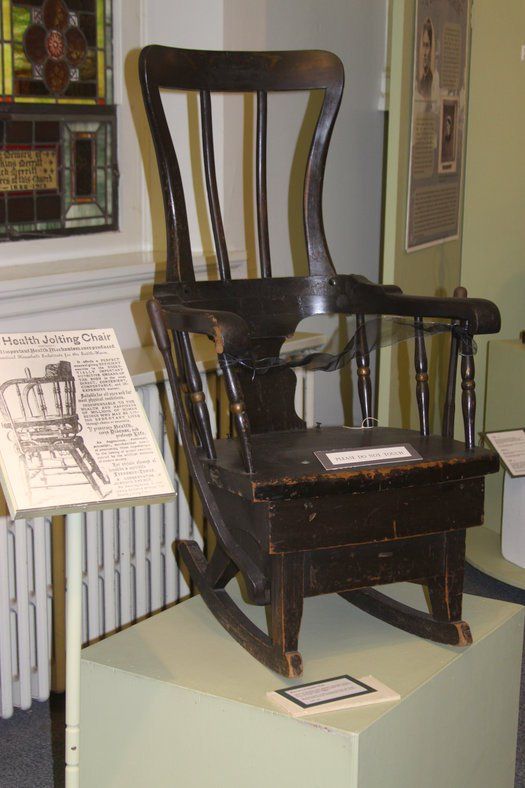
Pill Box c. 1860's - Pill box made of balsam wood, oval, small with cover. “Cephalic Pills”
Gift of anonymous donor
Blood Letting Instrument Date unknown - Metal with horn handle this blood letting instrument has three blades that open out.
Gift of C. E. Batchelder
Visual Acuity Chart Date unknown - Square wooden stick with numbers down its length. Tiny eye chart on sliding piece of wood, heavy card with lens both of which slide on wood stick to diagnose visual acuity.
Gift of anonymous donor
Vibrator c. 1905 - “Dr. Powell’s Vibrator”, used to suck air out of ears to help sunken ear drums and cure deafness. Has 2 black bakelite ear plugs and a mouth piece attached to short sections of rubber tubing.
Gift of Helen T. Clark
Medical and Psychological c. 1920's - “Renulife” machine for electric treatment of diseases and conditions of the human body. An instruction booklet is included.
Gift of Helen Clarke Langdon
Doctors Bag c. 1920's - A doctors bag containing medicines in glass vials belonging to Doctor Sidney Pope Brown
Gift of Garry Brown
Eye Glasses Date unknown - Silver framed, oval lenses with small nose bar, and flat straight bows. The brown case opens on one end and has “J. F. Butler, Graduate Optician, 21 Market Street, Potsdam, N. Y.” printed on front.
Gift of Edwin M. Barry
Sun Glasses Date unknown - Sun glasses with wire frames, frosted brown oval lenses having a clear spot in their center, and thin curved wire bows. The black case opens at one end and has “John Joy, Practical Optician, Potsdam, N. Y.” printed on front.
Gift of Roger Fadden
Eye Glasses c. 1920’s - Eye glasses, silver frame with etched design, oval lenses, pince-nez style. Case: black with black velvet lining. “W.M. Reynolds, M.D., 14 Elm St., Potsdam, N.Y.” embossed in gold on case edge.
Gift of anonymous donor.
Baby Vaporizer c.1900 - Made of metal, glass and wick in original boxManufactured by Vapo-Cresolene Co.
Loaned by Carl Stickney
Medical c.1800s - Pill making machine, also known as a "pill roller". Base and paddle constructed of wood and brass. "The early pharmacist slid the top paddle over the matching base, cutting a dough-like, medicinal mixture into cylindrical tubes. The tubes were then placed on a pill tile, measured and cut with a pill knife to sizes providing the proper dosages." Quote from Stonegate Antiques web site.
Loaned by Carl Stickney
Visual Acuity Chart c. 1880s Square metal rod with measurements down it's length. Sliding metal plate with dots of iminishing sizes, and instructions "Count the dots" engraved. Fixed eye-piece with lens. at end of rod. Instrument used to measure visual acuity.
Loaned by Carl Stickney
Lenses c. 1880s - Two (2) boxes of lenses used to determine visual acuity. Each lens has its own, unique number written on it. Box labeled “1 Doz., Convex Eye, ACME INTERCHANGEABLE LENSES, P. A. Hardy & Co, Chicago”
Loaned by Carl Stickney
Eye Glasses Date unknown - Eye glasses, gold plated finish on pince-nez style frame, oval lenses.
Loaned by Carl Stickney
Medicinal Date unknown - “The LYCOSITE”, used to “Instantly relieve All Superficial Pains, Headache, Toothache, Neuralgia, Rheumatism, Woman’s Monthly Pains, Pain in the Side, Back, Lungs, Joints, Muscles or Kidneys, Pain Anywhere”. Has tubing, bottle for “lycosite fluid”, And glass containers with sponges to hold fluid. Directions inside lid.
Loaned by Tim O’Brien
Medical, Aural Dates unknown - Three (3) ear trumpets or horns brass. Left: Brass, collapsible Middle: Black painted brass Right: Tin
Loaned by Carl Stickney
Medicinal (back) c. 1880 - 1890 - Stoneware linament bottle, “J. FLEMING” embossed in blue. Label : “LINIMENT, M. F. Collins & Son, Druggist and Stationers, Norwood, New York”
Medicinal c. 1900 - Bottle, green tinted glass, with “PSYCHINE FOR CONSUMPTION, DR. T. A. SLOCUM, 18 PEARL ST. NEW YORK” in raised letters around and under an Anchor, also raised, on back. Front has paper label: Cayenne Pepper 1 oz., Alcohol 3 oz.” written in ink And “M.F.COLLINS & SON, DRUGGISTS, Norwood, New York” printed
Medicinal c. 1900 - Bottle, clear glass with corked top. “FOLEY’S HONEY AND TAR, FOLEY & CO., CHICAGO. U.S.A.” in raised letters on the back. Front of bottle has paper label with “FOLEY’S Honey And Tar for Coughs, Colds, Hoarse-ness, Croup, Whooping Cough, Sore Throat, Asthma, Difficulty Breathing, Bronchitis, Spitting of Blood, and the Various affections of the Throat, Chest and Lungs”. “PRICE 50 CENTS, SOLD BY ALL DRUGGISTS”. Label also has complete set of directions etc.
Medical c. 1900 - Large glass bottle, green tinted, with “14 ½ ozs., LYDIA E. PINKHAM’S VEGETABLE COMPOUND” in raised letters on front.
Medicinal c. 1880s - Bottle, green tinted glass with heavily textured surface. “Vapo-Cresolene C.” embossed on side. Textured surface was a warning that the contents were poisonous.
Five containers loaned by Carl Stickney
Doctors Bag c. 1950 – 1980 - A doctors bag containing medical tools Belonging to Doctor Edward S. Prescott.
Gift of Reg and Lucy Bowden
